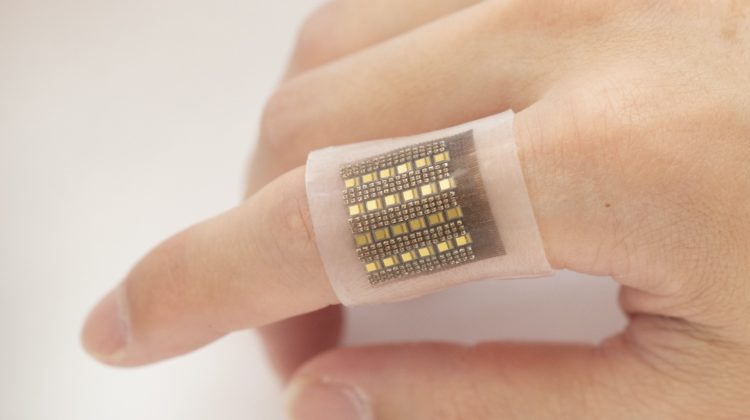
A team of engineers at the University of California San Diego has developed an electronic patch that can monitor biomolecules such as haemoglobin in deep tissues, giving medical professionals unprecedented access to crucial information that could help spot life-threatening conditions such as malignant tumours, organ dysfunction, cerebral or gut haemorrhages and more.
‘The amount and location of haemoglobin in the body provide critical information about blood perfusion or accumulation in specific locations. Our device shows great potential in close monitoring of high-risk groups, enabling timely interventions at urgent moments,’ said Sheng Xu, a professor of nanoengineering at UC San Diego.
Low blood perfusion inside the body may cause severe organ dysfunctions and is associated with a range of ailments, including heart attacks and vascular diseases of the extremities. At the same time, abnormal blood accumulation in areas such as in the brain, abdomen or cysts can indicate cerebral or visceral haemorrhage or malignant tumours. Continuous monitoring can aid diagnosis of these conditions and help facilitate timely and potentially life-saving interventions.
The new sensor overcomes some significant limitations in existing methods of monitoring biomolecules. Magnetic resonance imaging and X-ray-computed tomography rely on bulky equipment that can be difficult to procure and usually only provide information on the immediate status of the molecule, which makes them unsuitable for long-term biomolecule monitoring.
‘Continuous monitoring is critical for timely interventions to prevent life-threatening conditions from worsening quickly,’ said Xiangjun Chen, a nanoengineering PhD student. ‘Wearable devices based on electrochemistry for biomolecules detection, not limited to haemoglobin, are good candidates for long-term wearable monitoring applications. However, the existing technologies only achieve the ability of skin-surface detection.’
The new, flexible, low-form-factor wearable patch comfortably attaches to the skin, allowing for non-invasive long-term monitoring. It can perform three-dimensional mapping of haemoglobin with a sub-millimetre spatial resolution in deep tissues, down to centimetres below the skin; other wearable electrochemical devices typically only sense the biomolecules on the skin surface.
The patch is equipped with arrays of laser diodes and piezoelectric transducers set in a soft silicone-polymer matrix. Laser diodes emit pulsed lasers into the tissues. Biomolecules in the tissue absorb the optical energy and radiate acoustic waves into surrounding media. Due to its optical selectivity, it can expand the range of detectable molecules, integrating different laser diodes with different wavelengths, along with its potential clinical applications.
‘Piezoelectric transducers receive the acoustic waves, which are processed in an electrical system to reconstruct the spatial mapping of the wave-emitting biomolecules’, said Xiaoxiang Gao, a postdoctoral researcher.
‘With its low-power laser pulses, it is also much safer than X-ray techniques, which have ionising radiation,’ said postdoctoral researcher Hongjie Hu.
Based on its success so far, the team plans to further develop the device, including shrinking the backend controlling system to a portable-sized device for laser diode driving and data acquisition, greatly expanding its flexibility and potential clinical utility.
They also plan to explore the wearable’s potential for core-temperature monitoring. ‘Because the photoacoustic signal amplitude is proportional to the temperature, we have demonstrated core temperature monitoring on ex-vivo experiments,’ Xu said. ‘However, validating the core-temperature monitoring on the human body requires interventional calibration.’
They are continuing to work with physicians to pursue more potential clinical applications.
The research has been published in Nature Communications.


